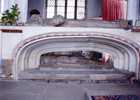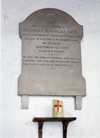For this church:    |
|
In Loving Memory of HERBERT CHARLES KEY, LANCE-CORPORAL ⅛TH SHERWOOD FORESTERS KILLED IN ACTION IN NO MAN’S LAND SEPTEMBER 12TH 1917, AGED 22 YEARS.  HE DIED THE NOBLEST DEATH A MAN MAY DIE FIGHTING FOR GOD, AND RIGHT, AND LIBERTY, AND SUCH A DEATH IS IMMORTALITY  |
The official entry says he was born in Holme and enlisted in Newark. He is listed in records as “killed in action in France/Flanders.” The 1/8th Sherwood Foresters were involved in 1916 in the Somme offensive and in 1917 near Ypres at Passchendale which was the most dreaded part of the line for soldiers. L/C Key was, therefore, involved in some of the worst trench warfare in the 1st World War, most probably going “over the top”. Grave markers on the north side of the church bear the “Key” family name, presumably parents and brother.
Within ten metres is the grave of another soldier, Arthur Deane, 305800, who, records show, enlisted like Herbert Key at Newark and was also a lance-corporal in the 1/8th Sherwood Foresters. He died of wounds two months after Herbert Key, also in France.
 The Barton Tomb
The Barton Tomb
John Barton, the Lancashire-born wool merchant who rebuilt Holme church around 1485, commissioned this tomb for himself and his wife during their lifetime. In his will (which is still in existence) dated 10th December 1490 he directs that his body is to be buried “in my new tomb in the chapel newly constructed by me in Holme”. The will also mentions his wife Isabella; his son Ralph and his wife Joan and their son and heir, John; his sons Thomas, Robert and Richard; his daughters Katherine and Isabella Tamworth, and his sisters Margaret Spencer and Marian. Ralph was directed to find a fit priest to celebrate mass for the salvation of his soul.
The recumbent figures lie above a corpse in a shroud as a ‘memento mori’; a reminder of what all must come to. On the sides of the tomb at the base is an inscription taken from the book of Job: ‘Miseremini mei miseremini mei saltem vos amicimei quia manus domini tetigit me’. (‘Pity me pity me you at least my friends for the hand of the Lord has touched me’).
He is clothed as a merchant of the fifteenth century, with his feet resting on a tun with a bar across it for ‘Barton’. He wears a cassock gown with a plain waist belt from which hangs his purse-pocket, decorated with five balls. On his right side, what appears to be the battered remains of his rosary can be seen.
Isabella wears a high-waisted dress with a tight bodice. Her belt is trimmed with squares and has a tongue decorated with Gothic leaves. Her headdress, a form of the ‘Butterfly’, comprises a gauze veil hung over wires worn over a linen skull cap. Her feet rest on a dog.
From the lined and firm character of John Barton’s face, it would appear that these figures are life-like representations and not idealised portraits.
During the church’s restoration in the 1930’s six blank shields around the base of the tomb were painted with heraldry copied from the Barton shields on the porch and during the same period other traditional decoration was added.
Grave slab, south side of the Lady Chapel
| Here lie interred ye Body of John Belasys of Holme in the County of Nottingham, Esquire, And of Cathrine (sic) his wife. Catherine Dyed the 10th of March, 1716, and Mr. Belasyse the 10th of April, 1717. Requiescant in Pace. |
John Belasys was a descendant of the last of the Bartons. John and Catherine married in November 1716 but he died the following April, one month after his wife and their lines came to an end. The Barton estates passed to the Earl of Fauconberg who, in about 1780, sold them to the Duke of Newcastle. A member of the Belasys (Bellasis) family had been Governor of Newark during its last siege in the Civil War.







